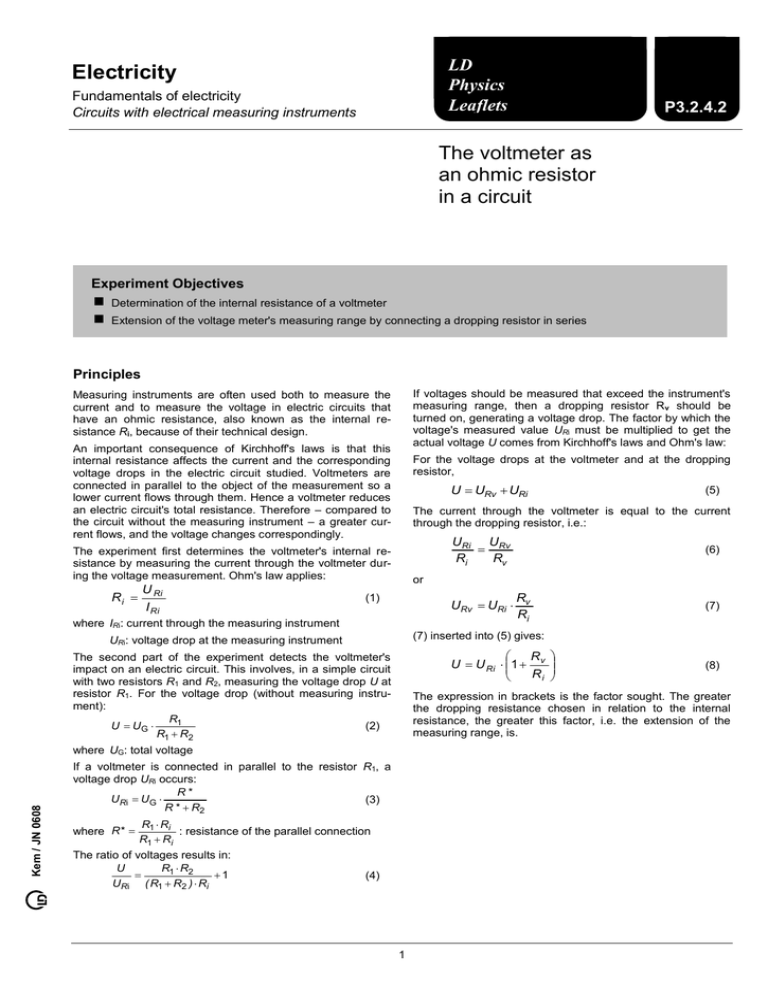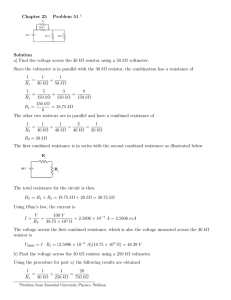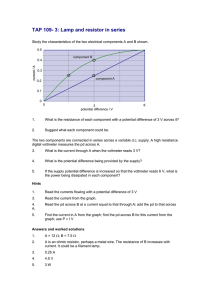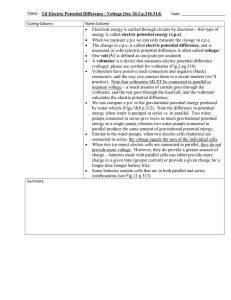P3.2.4.2 The voltmeter as an ohmic resistor in a circuit
advertisement

LD Physics Leaflets Electricity Fundamentals of electricity Circuits with electrical measuring instruments P3.2.4.2 The voltmeter as an ohmic resistor in a circuit Experiment Objectives Determination of the internal resistance of a voltmeter Extension of the voltage meter's measuring range by connecting a dropping resistor in series Principles If voltages should be measured that exceed the instrument's measuring range, then a dropping resistor Rv should be turned on, generating a voltage drop. The factor by which the voltage's measured value URi must be multiplied to get the actual voltage U comes from Kirchhoff's laws and Ohm's law: Measuring instruments are often used both to measure the current and to measure the voltage in electric circuits that have an ohmic resistance, also known as the internal resistance Ri, because of their technical design. An important consequence of Kirchhoff's laws is that this internal resistance affects the current and the corresponding voltage drops in the electric circuit studied. Voltmeters are connected in parallel to the object of the measurement so a lower current flows through them. Hence a voltmeter reduces an electric circuit's total resistance. Therefore – compared to the circuit without the measuring instrument – a greater current flows, and the voltage changes correspondingly. For the voltage drops at the voltmeter and at the dropping resistor, U URv URi The current through the voltmeter is equal to the current through the dropping resistor, i.e.: URi URv Ri Rv The experiment first determines the voltmeter's internal resistance by measuring the current through the voltmeter during the voltage measurement. Ohm's law applies: U R i Ri I Ri (1) URv URi R U U Ri 1 v Ri The second part of the experiment detects the voltmeter's impact on an electric circuit. This involves, in a simple circuit with two resistors R1 and R2, measuring the voltage drop U at resistor R1. For the voltage drop (without measuring instrument): R1 U UG (2) R1 R2 (7) (8) The expression in brackets is the factor sought. The greater the dropping resistance chosen in relation to the internal resistance, the greater this factor, i.e. the extension of the measuring range, is. where UG: total voltage Kem / JN 0608 Rv Ri (7) inserted into (5) gives: URi: voltage drop at the measuring instrument If a voltmeter is connected in parallel to the resistor R1, a voltage drop URi occurs: R* U Ri U G (3) R * R2 R1 Ri : resistance of the parallel connection R1 Ri The ratio of voltages results in: U R1 R2 1 URi ( R1 R2 ) Ri (6) or where IRi: current through the measuring instrument where R* (5) (4) 1 P3.2.4.1 LD Physics leaflets b) Impact of the voltmeter on the voltage Apparatus + 2 Multimeter LDanalog 10 .................................. 531 110 1 Plug-in board DIN A4 ...................................... 576 74 1 Resistor 680 k, STE ..................................... 577 75 1 Resistor 4.7 k, STE ...................................... 577 52 1 Resistor 220 k, STE ..................................... 577 71 1 Bridging plugs STE 2/19, set of 10 ................. 501 48 4.7 k 1 DC power supply 0 to 15 V ........................... 521 45 3 Connecting lead 19 A, 50 cm, red/blue, pair ... 501 45 U V* 220 k V Fig. 2 Setup and carrying out the experiment - Experiment setup according to fig. 2. Choose a measuring range of 1 V on the voltmeter V*. a) Determination of the internal resistance - Increase the voltage until the voltmeter V* has a voltage of U = 1 V. - Connect the voltmeter V in parallel and make a note of the voltage. - Set the voltage back to 0 V. 4.7 k + A c) Extension of the measuring range + U V RV - U V* Fig. 1 - Experiment setup according to fig. 1. Pay attention to the measured quantities and polarities on the measuring instruments. Use the dropping resistor 4.7 k to protect the ammeter also. - Choose a measuring range on the ammeter of 50 A and on the voltmeter of 1 V. - Turn on the power supply and increase the voltage until the voltmeter has a voltage of U = 1 V. - Measure the voltage and current and note them in Table 1. - Set the voltage back to 0 V. V - Fig. 3 2 - Experiment setup according to fig. 3. Pay attention to the measured quantities and polarities on the measuring instruments. - Set a measuring range on the voltmeter V* of 10 V. - Initially choose a dropping resistance RV = 220 k. - Increase the voltage until the voltmeter V* has a voltage of U = 10 V. - Read the voltage on the meter V and enter it into Table 2. - Implement further resistances according to Table 2 and repeat the experiment. P3.2.4.1 LD Physics leaflets Measurement Example Evaluation a) Determination of the internal resistance a) Determination of the internal resistance Table 1: - Calculate the internal resistance Ri according to (1) and enter it into Table 1. - The internal resistance of the voltmeter 531 110 in the 1 V measuring range amounts to about 20 k . U V I A Ri k 1.0 50 20 Remark: Many voltmeters indicate the internal resistance value in k /V. The internal resistance comes from the product of the measuring range (end value of the measuring range) with this value. Example: 20 k /V in the 1 V measuring range . Ri = 20 k /V 1 V = 20 k b) Impact of the voltmeter on the voltage b) Impact of the voltmeter on the voltage - Result: - U = 0.84 V The resistance subject to the measurement consists of the resistance R = 220 k and the internal resistance of the voltmeter V*. This results in 220 k 20 k R1 18.3 k 220 k 20 k and with Formula (4): U 18.3 k 4.7 k 1 1.19 URi (18.3 k 4.7 k ) 20 k i.e. URi 0.84 V which is in line with the measured value. - Using the voltmeter decreased the voltage drop by a factor of 0.84. Remark: A voltmeter's internal resistance should thus be high compared to the resistance subject to measurement, so the measurement's impact remains insignificant. c) Extension of the measuring range c) Extension of the measuring range Rv Ri RV k U V U Ri V U U Ri 220 10 0.83 12 12 680 10 0.29 34 35 900 10 0.22 45 46 1 - Calculate the ratio of the voltage U to the measured voltage URi and the factor for extending the measuring range per (5), and enter them in Table 2. - Connecting a resistor RV in series increases the measur- ing range by a factor of 1 - Rv Ri . Greater voltages can now be measured in the 1 V measuring range. Remark: High-voltage probes use dropping resistances for high voltages. They are usually designed so the corresponding measuring range increases by a factor of 10 or 100. LD DIDACTIC GmbH Leyboldstraße 1 D-50354 Hürth Phone (02233) 604-0 Telefax (02233) 604-222 E-mail: info@ld-didactic.de by LD DIDACTIC GmbH Technical alterations reserved






